Probabilistic Seismic Hazard Assessment of the Southwestern Region of Saudi Arabia
Abstract
:1. Introduction
2. Methodology
2.1. Earthquake and Focal Mechanism Catalogs
2.2. Seismic Source Model
2.3. Ground Motion Prediction Equations
2.4. Estimation of Seismic Hazard by Using a Logic Tree
3. Results and Discussion
4. Summary and Conclusions
Author Contributions
Funding
Institutional Review Board Statement
Informed Consent Statement
Data Availability Statement
Acknowledgments
Conflicts of Interest
References
- Das, R.; Gonzalez, G.; de la Llera, J.C.; Saez, E.; Salazar, P.; Gonzalez, J.; Meneses, C. A Probabilistic Seismic Hazard Assessment of Southern Peru and Northern Chile. Eng. Geol. 2020, 271, 105585. [Google Scholar] [CrossRef]
- Falcone, G.; Mendicelli, A.; Mori, F.; Fabozzi, S.; Moscatelli, M.; Occhipinti, G.; Peronace, E. A Simplified Analysis of the Total Seismic Hazard in Italy. Eng. Geol. 2020, 267, 105511. [Google Scholar] [CrossRef]
- Viveros, J.A.B.; Reynoso, G.S.; Schroeder, M.G.O. A Probabilistic Seismic Hazard Assessment of the Trans-Mexican Volcanic Belt, Mexico Based on Historical and Instrumentally Recorded Seismicity. Geofis. Int. 2017, 56, 87–101. [Google Scholar] [CrossRef]
- Johnson, P. Tectonic Map of Saudi Arabia and Adjacent Areas; Technical Report USGS-TR-98-3 (IR 948); United States Geological Survey: Reston, VA, USA, 1998.
- Reilinger, R.; McClusky, S.; Vernant, P.; Lawrence, S.; Ergintav, S.; Cakmak, R.; Ozener, H.; Kadirov, F.; Guliev, I.; Stepanyan, R.; et al. GPS Constraints on Continental Deformation in the Africa-Arabia-Eurasia Continental Collision Zone and Implications for the Dynamics of Plate Interactions. J. Geophys. Res. Solid. Earth 2006, 111, B05411. [Google Scholar] [CrossRef]
- ArRajehi, A.; McClusky, S.; Reilinger, R.; Daoud, M.; Alchalbi, A.; Ergintav, S.; Gomez, F.; Sholan, J.; Bou-Rabee, F.; Ogubazghi, G.; et al. Geodetic Constraints on Present-Day Motion of the Arabian Plate: Implications for Red Sea and Gulf of Aden Rifting. Tectonics 2010, 29, 2006–2010. [Google Scholar] [CrossRef]
- Bosworth, W.; Khalil, S.M.; Ligi, M.; Stockli, D.F.; McClay, K.R. Geology of Egypt: The Northern Red Sea. In The Geology of Egypt; Springer: Cham, Switzerland, 2020; pp. 343–374. [Google Scholar]
- Almalki, K.A.; Betts, P.G.; Ailleres, L. The Red Sea—50 Years of Geological and Geophysical Research. Earth-Sci. Rev. 2015, 147, 109–140. [Google Scholar] [CrossRef]
- Ghebreab, W. Tectonics of the Red Sea Region Reassessed. Earth-Sci. Rev. 1998, 45, 1–44. [Google Scholar] [CrossRef]
- Watchorn, F.; Nichols, G.J.; Bosence, D.W.J. Rift-Related Sedimentation and Stratigraphy, Southern Yemen (Gulf of Aden). In Sedimentation and Tectonics in Rift Basins Red Sea: Gulf of Aden; Springer: Dordrecht, The Netherlands, 1998; pp. 165–189. [Google Scholar]
- Hughes, G.W.; Varol, O.; Beydoun, Z.R. Evidence for Middle Oligocene Rifting of the Gulf of Aden and for Late Oligocene Rifting of the Southern Red Sea. Mar. Pet. Geol. 1991, 8, 354–358. [Google Scholar] [CrossRef]
- Al-Amri, A.M. Seismotectonics and Seismogenic Source Zones of the Arabian Platform. In Lithosphere Dynamics and Sedimentary Basins: The Arabian Plate and Analogues; Springer: Berlin/Heidelberg, Germany, 2013; pp. 295–316. [Google Scholar]
- Al-Haddad, M.; Siddiqi, G.; Al-Zaid, R.; Arafah, A.; Necioglu, A.; Turkelli, N. Seismic Hazard and Design Criteria for Saudi Arabia. In Proceedings of the 10th World Conference on Earthquake Engineering, Madrid, Spain, 19–24 July 1992; Balkema: Rotterdam, The Netherlands, 1992; pp. 449–454. [Google Scholar]
- Al-Haddad, M.; Siddiqi, G.H.; Al-Zaid, R.; Arafah, A.; Necioglu, A.; Turkelli, N. A Basis for Evaluation of Seismic Hazard and Design Criteria for Saudi Arabia. Earthq. Spectra 1994, 10, 231–258. [Google Scholar] [CrossRef]
- Merghelani, H.M. Seismicity of the Yanbu Region Kingdom of Saudi Arabia; Saudi Arabia Project Report 371; Technical Records 16; Ministry of Petroleum and Mineral Resources: Jiddah, Saudi Arabia, 1981.
- Fnais, M.S.; Abdelrahman, K.; E-Hady, S.; Abdel-Monem, E. Seismicity and Seismotectonics of the Jeddah Area, Saudi Arabia. In Proceedings of the WIT Transactions on the Built Environment; 2013; Volume 132, pp. 219–232. [Google Scholar]
- Thenhaus, P.; Algermissen, S.; Perkins, D.; Hanson, S.; Diment, W. Probabilistic Estimates of the Seismic Ground-Motion Hazard in Western Saudi Arabia; U.S. Geological Survey: Reston, VA, USA, 1989; Volume 42.
- Nahhas, T.M. A Comparison of Saudi Building Code with 1997 UBC for Provisions of Modal Response Spectrum Analysis Using a Real Building. Open J. Earthq. Res. 2017, 6, 98–116. [Google Scholar] [CrossRef]
- Al-Arifi, N.S.; Fat-Helbary, R.E.; Khalil, A.R.; Lashin, A.A. A New Evaluation of Seismic Hazard for the Northwestern Part of Saudi Arabia. Nat. Hazards 2013, 69, 1435–1457. [Google Scholar] [CrossRef]
- Zahran, H.M.; Sokolov, V.; Youssef, S.E.H.; Alraddadi, W.W. Preliminary Probabilistic Seismic Hazard Assessment for the Kingdom of Saudi Arabia Based on Combined Areal Source Model: Monte Carlo Approach and Sensitivity Analyses. Soil. Dyn. Earthq. Eng. 2015, 77, 453–468. [Google Scholar] [CrossRef]
- Anbazhagan, P.; Smitha, C.V.; Kumar, A. Representative Seismic Hazard Map of Coimbatore, India. Eng. Geol. 2014, 171, 81–95. [Google Scholar] [CrossRef]
- Gasperini, P.; Lolli, B.; Castellaro, S. Comparative Analysis of Regression Methods Used for Seismic Magnitude Conversions. Bull. Seismol. Soc. Am. 2015, 105, 1787–1791. [Google Scholar] [CrossRef]
- Liu, J.; Wang, Z.; Xie, F.; Lv, Y. Seismic Hazard Assessment for Greater North China from Historical Intensity Observations. Eng. Geol. 2013, 164, 117–130. [Google Scholar] [CrossRef]
- Petersen, M.D.; Shumway, A.M.; Powers, P.M.; Mueller, C.S.; Moschetti, M.P.; Frankel, A.D.; Rezaeian, S.; McNamara, D.E.; Luco, N.; Boyd, O.S.; et al. The 2018 Update of the US National Seismic Hazard Model: Overview of Model and Implications. Earthq. Spectra 2020, 36, 5–41. [Google Scholar] [CrossRef]
- Tselentis, G.A.; Danciu, L. Probabilistic Seismic Hazard Assessment in Greece—Part 3: Deaggregation. Nat. Hazards Earth Syst. Sci. 2010, 10, 51–59. [Google Scholar] [CrossRef]
- Yazdani, A.; Kowsari, M. A Probabilistic Procedure for Scenario-Based Seismic Hazard Maps of Greater Tehran. Eng. Geol. 2017, 218, 162–172. [Google Scholar] [CrossRef]
- FEMA—Federal Emergency Management Agency. NEHRP Recommended Seismic Provisions for New Buildings and Other Structures; Building Seismic Safety Council: Washington, DC, USA, 2015; Volume I, p. 515. [Google Scholar]
- Cornell, C.A. Engineering Seismic Risk Analysis. Bull. Seismol. Soc. Am. 1968, 58, 1583–1606. [Google Scholar] [CrossRef]
- Esteva, L.R. Regionalizacion Sismica de la Republica Mexicana. Rev. Soc. Mex. Ing. Sismica 1963, 1, 31–35. [Google Scholar]
- McGuire, R.K. FORTRAN Computer Program for Seismic Risk Analysis; U.S. Geological Survey: Lemoyne, PA, USA, 1976.
- SSHAC—Senior Seismic Hazard Analysis Committee. Recommendations for Probabilistic Recommendations for Probabilistic Seismic Hazard Analysis: Guidance on Uncertainty and Use of Experts; Report NUREG-CR-6372; U.S. Nuclear Regulatory Commission: Washington, DC, USA, 1997; Volume 2.
- Alamilla, J.L.; Rodriguez, J.A.; Vai, R. Unification of Different Approaches to Probabilistic Seismic Hazard Analysis. Bull. Seismol. Soc. Am. 2020, 110, 2816–2827. [Google Scholar] [CrossRef]
- Ayele, A. Probabilistic Seismic Hazard Analysis (PSHA) for Ethiopia and the Neighboring Region. J. Afr. Earth Sci. 2017, 134, 257–264. [Google Scholar] [CrossRef]
- El-Hussain, I.; Al-Shijbi, Y.; Deif, A.; Mohamed, A.M.E.; Ezzelarab, M. Developing a Seismic Source Model for the Arabian Plate. Arab. J. Geosci. 2018, 11, 11–435. [Google Scholar] [CrossRef]
- Reiter, L. Earthquake Hazard Analysis: Issues and Insights; Columbia University Press: New York City, NY, USA, 1990; ISBN 0-231-06534-5. [Google Scholar]
- United States Nuclear Regulatory Commission. Updated Implementation Guidelines for SSHAC Hazard Studies; NUREG-2213; US Nuclear Regulatory Commission: Washington, DC, USA, 2018; ISBN 1800553684.
- International Building Code (IBC). International Building Code; International Code Council, Inc.: Washington, DC, USA, 2009; ISBN 978-1-58001-725-1. [Google Scholar]
- EN-1998-1; Eurocode 8: Design of Structures for Earthquake Resistance. Part 1: General Rules, Seismic Actions and Rules for Buildings. European Committee for Standardization: Brussels, Belgium, 2003.
- Ordaz, M.; Arroyo, D. On Uncertainties in Probabilistic Seismic Hazard Analysis. Earthq. Spectra 2016, 32, 1405–1418. [Google Scholar] [CrossRef]
- Sawires, R.; Peláez, J.A.; AlHamaydeh, M.; Henares, J. A State-of-the-Art Seismic Source Model for the United Arab Emirates. J. Asian Earth Sci. 2019, 186, 104063. [Google Scholar] [CrossRef]
- Sawires, R.; Peláez, J.A.; Ibrahim, H.A.; Fat-Helbary, R.E.; Henares, J.; Hamdache, M. Delineation and Characterization of a New Seismic Source Model for Seismic Hazard Studies in Egypt. Nat. Hazards 2016, 80, 1823–1864. [Google Scholar] [CrossRef]
- Deif, A.; Al-Shijbi, Y.; El-Hussain, I.; Ezzelarab, M.; Mohamed, A.M.E. Compiling an Earthquake Catalogue for the Arabian Plate, Western Asia. J. Asian Earth Sci. 2017, 147, 345–357. [Google Scholar] [CrossRef]
- Engdahl, E.R.R.; van der Hilst, R.; Buland, R. Global Teleseismic Earthquake Relocation with Improved Travel Times and Procedures for Depth Determination. Bull. Seismol. Soc. Am. 1998, 88, 722–743. [Google Scholar] [CrossRef]
- Ambraseys, N.N.; Melville, C.P.; Adams, R.D. The Seismicity of Egypt, Arabia and the Red Sea: A Historical Review; Cambridge University Press: New York, NY, USA, 1994. [Google Scholar]
- Ambraseys, N.N. Far-Field Effects of Eastern Mediterranean Earthquakes in Lower Egypt. J. Seism. 2001, 5, 263–268. [Google Scholar] [CrossRef]
- Aldama-Bustos, G.; Bommer, J.J.; Fenton, C.H.; Staford, P.J. Probabilistic Seismic Hazard Analysis for Rock Sites in the Cities of Abu Dhbi, Dubai and Ra’s Al Khymah, United Arab Emirates. Georisk 2009, 3, 1–29. [Google Scholar]
- El-Hussain, I.; Deif, A.; Al-Jabri, K.; Toksoz, N.; El-Hady, S.; Al-Hashmi, S.; Al-Toubi, K.; Al-Shijbi, Y.; Al-saifi, M.; Kuleli, S. Probabilistic Seismic Hazard Maps for the Sultanate of Oman. Nat. Hazards 2012, 64, 173–210. [Google Scholar] [CrossRef]
- Babiker, N.; Mula, A.; El-Hadidy, S. A Unified Mw-Based Earthquake Catalogue and Seismic Source Zones for the Red Sea. J. Afr. Earth Sci. 2015, 109, 168–176. [Google Scholar] [CrossRef]
- Erdik, M.; Şeşetyan, K.; Demircioğlu, M.B.; Tüzün, C.; Giardini, D.; Gülen, L.; Akkar, D.S.; Zare, M. Assessment of Seismic Hazard in the Middle East and Caucasus: EMME (Earthquake Model of Middle East) Project. In Proceedings of the 15th World Conference on Earthquake Engineering, Lisbon, Portugal, 24–28 September 2012. [Google Scholar]
- Sawires, R.; Santoyo, M.A.; Peláez, J.A.; Fernández, R.D.C. An Updated and Unified Earthquake Catalog from 1787 to 2018 for Seismic Hazard Assessment Studies in Mexico. Sci. Data 2019, 6, 241. [Google Scholar] [CrossRef]
- Sawires, R.; Peláez, J.A.; AlHamaydeh, M.; Henares, J. Up-to-Date Earthquake and Focal Mechanism Solutions Datasets for the Assessment of Seismic Hazard in the Vicinity of the United Arab Emirates. Data Brief. 2020, 28, 104844. [Google Scholar] [CrossRef]
- Gardner, J.K.; Knopoff, L. Is the Sequence of Earthquakes in Southern California, with Aftershocks Removed, Poissonian? Bull. Seismol. Soc. Am. 1974, 64, 1363–1367. [Google Scholar] [CrossRef]
- Uhrhammer, R. Northern California Seismicity. In Neotectonics of North America; Burton Slemmons, D., Engdahl, E.R., Zoback, M.D., Blackwell, D.D., Eds.; GeoScienceWorld: McLean, VA, USA, 1991. [Google Scholar] [CrossRef]
- Burkhard, M.; Grünthal, G. Seismic Source Zone Characterization for the Seismic Hazard Assessment Project PEGASOS by the Expert Group 2 (EG1b). Swiss J. Geosci. 2009, 102, 149–188. [Google Scholar] [CrossRef]
- Fairhead, J.D.; Girdler, R.W. The Seismicity of the Red Sea, Gulf of Aden and Afar Triangle. Philos. Trans. R. Soc. Lond. Ser. A Math. Phys. Sci. 1970, 267, 49–74. [Google Scholar] [CrossRef]
- Huang, P.Y.; Solomon, S.C. Centroid Depths and Mechanisms of Mid-ocean Ridge Earthquakes in the Indian Ocean. Gulf of Aden, and Red Sea. J. Geophys. Res. Solid. Earth 1987, 92, 1361–1382. [Google Scholar] [CrossRef]
- Pallister, J.S. Explanatory Notes to the Geologic Map of Al Lith Quadrangle, Sheet 20 MD, Kingdom of Saudi Arabia: Saudi Arabia Deputy Ministry for Mineral Resources; Open File Report USGSOF-04-8; U.S. Geological Survey: Reston, VA, USA, 1984.
- Greenwood, W.R.; Anderson, R.E.; Fleck, R.J.; Roberts, R.J. Precambrian Geologic History and Plate Tectonic Evolution of the Arabian Shield; Bulletin 24; Saudi Arabian Directorate General of Mineral Resources: Jiddah, Saudi Arabia, 1980.
- Youssef, S.E.-H. Seismicity and Seismotectonic Setting of the Red Sea and Adjacent Areas. In The Red Sea: The Formation, Morphology, Oceanography and Environment of a Young Ocean Basin; Springer: Berlin/Heidelberg, Germany, 2015; pp. 151–159. [Google Scholar]
- Girdler, R.W.; Styles, P. Two Stages Red Sea Floor Spreading. Nature 1974, 247, 7–11. [Google Scholar] [CrossRef]
- Hofstetter, R.; Beyth, M. The Afar Depression: Interpretation of the 1960-2000 Earthquakes. Geophys. J. Int. 2003, 155, 715–732. [Google Scholar] [CrossRef]
- Cornell, C.A.; Vanmarcke, E.H. The Major Influences on Seismic Risk. In Proceedings of the Fourth World Conference of Earthquake Engineering, Santiago, Chile, 13–18 January 1969. [Google Scholar]
- Kijko, A.; Sellevoll, M.A. Estimation of Earthquake Hazard Parameters from Incomplete Data Files, Part II. Bull. Seismol. Soc. Am. 1992, 82, 120–134. [Google Scholar]
- Gutenberg, B.; Richter, C.F. Magnitude and Energy of Earthquakes. Ann. Geofis. 1956, 9, 1–15. [Google Scholar]
- Kijko, A. Estimation of the Maximum Earthquake Magnitude, mmax. Pure Appl. Geophys. 2004, 161, 1655–1681. [Google Scholar] [CrossRef]
- Kijko, A.; Singh, M. Statistical Tools for Maximum Possible Earthquake Magnitude Estimation. Acta Geophys. 2011, 59, 674–700. [Google Scholar] [CrossRef]
- Vermeulen, P.; Kijko, A. More Statistical Tools for Maximum Possible Earthquake Magnitude Estimation. Acta Geophys. 2017, 65, 579–587. [Google Scholar] [CrossRef]
- Bommer, J.J.; Douglas, J.; Scherbaum, F.; Cotton, F.; Bungum, H.; Fah, D. On the Selection of Ground-Motion Prediction Equations for Seismic Hazard Analysis. Seismol. Res. Lett. 2010, 81, 783–793. [Google Scholar] [CrossRef]
- Douglas, J. Ground Motion Prediction Equations 1964–2021. 2022. Available online: http://www.gmpe.org.uk (accessed on 1 September 2022).
- Sawires, R.; Peláez, J.A.; Santoyo, M.A. Probabilistic Seismic Hazard Assessment for Western Mexico. Eng. Geol. 2023, 313, 106959. [Google Scholar] [CrossRef]
- Sawires, R.; Peláez, J.A.; Hamdache, M. Probabilistic Seismic Hazard Assessment for United Arab Emirates, Qatar and Bahrain. Appl. Sci. 2020, 10, 7901. [Google Scholar] [CrossRef]
- Hamdache, M.; Peláez, J.A.; Henares, J.; Sawires, R. Seismic Hazard Assessment and Its Uncertainty for the Central Part of Northern Algeria. Pure Appl. Geophys. 2022, 179, 2083–2118. [Google Scholar] [CrossRef]
- Sawires, R.; Peláez, J.A.; Santoyo, M.A. Deaggregation of Probabilistic Seismic Hazard Results for Some Selected Cities in Western Mexico. Georisk Assess. Manag. Risk Eng. Syst. Geohazards 2023, 18, 491–512. [Google Scholar] [CrossRef]
- Sawires, R.; Peláez, J.A.; Fat-Helbary, R.E.; Ibrahim, H.A. Updated Probabilistic Seismic-Hazard Values for Egypt. Bull. Seismol. Soc. Am. 2016, 106, 1788–1801. [Google Scholar] [CrossRef]
- Abrahamson, N.A.; Silva, W.J.; Kamai, R. Summary of the ASK14 Ground Motion Relation for Active Crustal Regions. Earthq. Spectra 2014, 30, 1025–1055. [Google Scholar] [CrossRef]
- Campbell, K.W.; Bozorgnia, Y. NGA-West2 Ground Motion Model for the Average Horizontal Components of PGA, PGV, and 5% Damped Linear Acceleration Response Spectra. Earthq. Spectra 2014, 30, 1087–1115. [Google Scholar] [CrossRef]
- Chiou, B.S.-J.; Youngs, R.R. Update of the Chiou and Youngs NGA Model for the Average Horizontal Component of Peak Ground Motion and Response Spectra. Earthq. Spectra 2014, 30, 1117–1153. [Google Scholar] [CrossRef]
- Abrahamson, N.; Gregor, N.; Addo, K. BC Hydro Ground Motion Prediction Equations for Subduction Earthquakes. Earthq. Spectra 2016, 32, 23–44. [Google Scholar] [CrossRef]
- Parker, G.A.; Stewart, J.P.; Boore, D.M.; Atkinson, G.M.; Hassani, B. NGA-Subduction Global Ground Motion Models with Regional Adjustment Factors. Earthq. Spectra 2022, 38, 456–493. [Google Scholar] [CrossRef]
- Zhao, J.X.; Zhang, J.; Asano, A.; Ohno, Y.; Oouchi, T.; Takahashi, T.; Ogawa, H.; Irikura, K.; Thio, H.K.; Somerville, P.G.; et al. Attenuation Relations of Strong Ground Motion in Japan Using Site Classification Based on Predominant Period. Bull. Seismol. Soc. Am. 2006, 96, 898–913. [Google Scholar] [CrossRef]
- Atkinson, G.M.; Boore, D.M. Empirical Ground-Motion Relations for Subduction-Zone Earthquakes and Their Application to Cascadia and Other Regions. Bull. Seismol. Soc. Am. 2003, 93, 1703–1729. [Google Scholar] [CrossRef]
- Atkinson, G.M.; Boore, D.M. Earthquake Ground-Motion Prediction Equations for Eastern North America. Bull. Seismol. Soc. Am. 2006, 96, 2181–2205. [Google Scholar] [CrossRef]
- Campbell, K.W. Prediction of Strong Ground Motion Using the Hybrid Empirical Method and Its Use in the Development of Ground-Motion (Attenuation) Relations in Eastern North America. Bull. Seismol. Soc. Am. 2003, 93, 1012–1033. [Google Scholar] [CrossRef]
- Pezeshk, S.; Zandieh, A.; Tavakoli, B. Hybrid Empirical Ground-Motion Prediction Equations for Eastern North America Using NGA Models and Updated Seismological Parameters. Bull. Seism. Soc. Am. 2011, 101, 1859–1870. [Google Scholar] [CrossRef]
- Stewart, J.P.; Douglas, J.; Javanbarg, M.; Bozorgnia, Y.; Abrahamson, N.A.; Boore, D.M.; Campbell, K.W.; Delavaud, E.; Erdik, M.; Stafford, P.J. Selection of Ground Motion Prediction Equations for the Global Earthquake Model. Earthq. Spectra 2015, 31, 19–45. [Google Scholar] [CrossRef]
- Ancheta, T.D.; Darragh, R.B.; Stewart, J.P.; Silva, W.; Chiou, B.; Wooddell, K.; Graves, R.; Kottke, A.; Boore, D.; Kishida, T.; et al. PEER NGA-West2 Database. PEER Rep. 2014, 172. [Google Scholar] [CrossRef]
- Chiou, B.S.J.; Youngs, R.R. An NGA Model for the Average Horizontal Component of Peak Ground Motion and Response Spectra. Earthq. Spectra 2008, 24, 173–215. [Google Scholar] [CrossRef]
- McGuire, R.K. Probabilistic Seismic Hazard Analysis and Design Earthquakes: Closing the Loop. Bull. Seismol. Soc. Am. 1995, 85, 1275–1284. [Google Scholar] [CrossRef]
- Bommer, J.J. Earthquake Hazard and Risk Analysis for Natural and Induced Seismicity: Towards Objective Assessments in the Face of Uncertainty. Bull. Earthq. Eng. 2022, 20, 2825–3069. [Google Scholar] [CrossRef]
- Kulkarni, R.B.; Youngs, R.R.; Coppersmith, K.J. Assessment of Confidence Intervals for Results of Seismic Hazard Analysis. In Proceedings of the Eighth World Conference on Earthquake Engineering, San Francisco, CA, USA, 21–28 July 1984; Volume 1, pp. 263–270. [Google Scholar]
- Bommer, J.J.; Scherbaum, F. The Use and Misuse of Logic Trees in Probabilistic Seismic Hazard Analysis. Earthq. Spectra 2008, 24, 997–1009. [Google Scholar] [CrossRef]
- Al-Shijbi, Y.; El-Hussain, I.; Deif, A.; Al-Kalbani, A.; Mohamed, A.M.E. Probabilistic Seismic Hazard Assessment for the Arabian Peninsula. Pure Appl. Geophys. 2018, 176, 1503–1530. [Google Scholar] [CrossRef]
- Sawires, R.; Peláez, J.A.; Fat-Helbary, R.E.; Panzera, F.; Ibrahim, H.A.; Hamdache, M. Probabilistic Seismic Hazard Deaggregation for Selected Egyptian Cities. Pure Appl. Geophys. 2017, 174, 1581–1600. [Google Scholar] [CrossRef]
- Şeşetyan, K.; Danciu, L.; Tümsa, M.B.D.; Giardini, D.; Erdik, M.; Akkar, S.; Gülen, L.; Zare, M.; Adamia, S.; Ansari, A.; et al. The 2014 Seismic Hazard Model of the Middle East: Overview and Results. Bull. Earthq. Eng. 2018, 16, 3535–3566. [Google Scholar] [CrossRef]
- Kolathayar, S.; Sitharam, T.G. Characterization of Regional Seismic Source Zones in and around India. Seismol. Res. Lett. 2012, 83, 77–85. [Google Scholar] [CrossRef]
- Petersen, M.D.; Frankel, A.D.; Harmsen, S.C.; Mueller, C.S.; Haller, K.M.; Wheeler, R.L.; Wesson, R.L.; Zeng, Y.; Boyd, O.S.; Perkins, D.M.; et al. Documentation for the 2008 Update of the United States National Seismic Hazard Maps; Report 2008-1128; US Geological Survey: Reston, VA, USA, 2008; Volume 128.
- Ordaz, M.; Faccioli, E.; Martinelli, F.; Aguilar, A.; Arboleda, J.; Meletti, C.; D’Amico, V. R-CRISIS Ver 20.3.0. Program for Computing Seismic Hazard, Institute of Engineering; UNAM: Mexico City, Mexico, 2021. [Google Scholar]
- Ordaz, M.; Salgado-Galvez, M.A. R-CRISIS Validation and Verification Document: Program for Probabilistic Seismic Hazard Analysis; ERN Technical Report; Instituto de Ingeniería: Mexico City, Mexico, 2020. [Google Scholar]
- Newmark, N.M.; Hall, W.J. Earthquake Spectra and Design; Earthquake Engineering Research Institute: Oackland, CA, USA, 1982. [Google Scholar]
- Malhotra, P.K. Return Period of Design Ground Motions. Seismol. Res. Lett. 2005, 76, 693–699. [Google Scholar] [CrossRef]
- Sokolov, V.; Zahran, H.M.; Youssef, S.E.-H.; El-Hadidy, M.; Alraddadi, W.W. Probabilistic Seismic Hazard Assessment for Saudi Arabia Using Spatially Smoothed Seismicity and Analysis of Hazard Uncertainty. Bull. Earthq. Eng. 2017, 15, 2695–2735. [Google Scholar] [CrossRef]
- Akkar, S.; Sandıkkaya, M.A.; Bommer, J.J. Empirical Ground-Motion Models for Point- and Extended-Source Crustal Earthquake Scenarios in Europe and the Middle East. Bull. Earthq. Eng. 2014, 12, 359–387. [Google Scholar] [CrossRef]
- Boore, D.M.; Atkinson, G.M. Ground-Motion Prediction Equations for the Average Horizontal Component of PGA, PGV, and 5%-Damped PSA at Spectral Periods between 0.01 s and 10.0 s. Earthq. Spectra 2008, 24, 99–138. [Google Scholar] [CrossRef]
- Campbell, K.W.; Bozorgnia, Y. NGA Ground Motion Model for the Geometric Mean Horizontal Component of PGA, PGV, PGD and 5% Damped Linear Elastic Response Spectra for Periods Ranging from 0.01 to 10 s. Earthq. Spectra 2008, 24, 139–171. [Google Scholar] [CrossRef]
- Pankow, K.L. The SEA99 Ground-Motion Predictive Relations for Extensional Tectonic Regimes: Revisions and a New Peak Ground Velocity Relation. Bull. Seismol. Soc. Am. 2004, 94, 341–348. [Google Scholar] [CrossRef]
- Kataria, N.P.; Shrikhande, M.; Das, J.D. Deterministic Seismic Hazard Analysis of Andaman and Nicobar Islands. J. Earthq. Tsunami 2013, 7, 1350035. [Google Scholar] [CrossRef]
- Hamdache, M.; Peláez, J.A.; Talbi, A.; Mobarki, M.; Casado, C.L. Ground-Motion Hazard Values for Northern Algeria. Pure Appl. Geophys. 2012, 169, 711–723. [Google Scholar] [CrossRef]
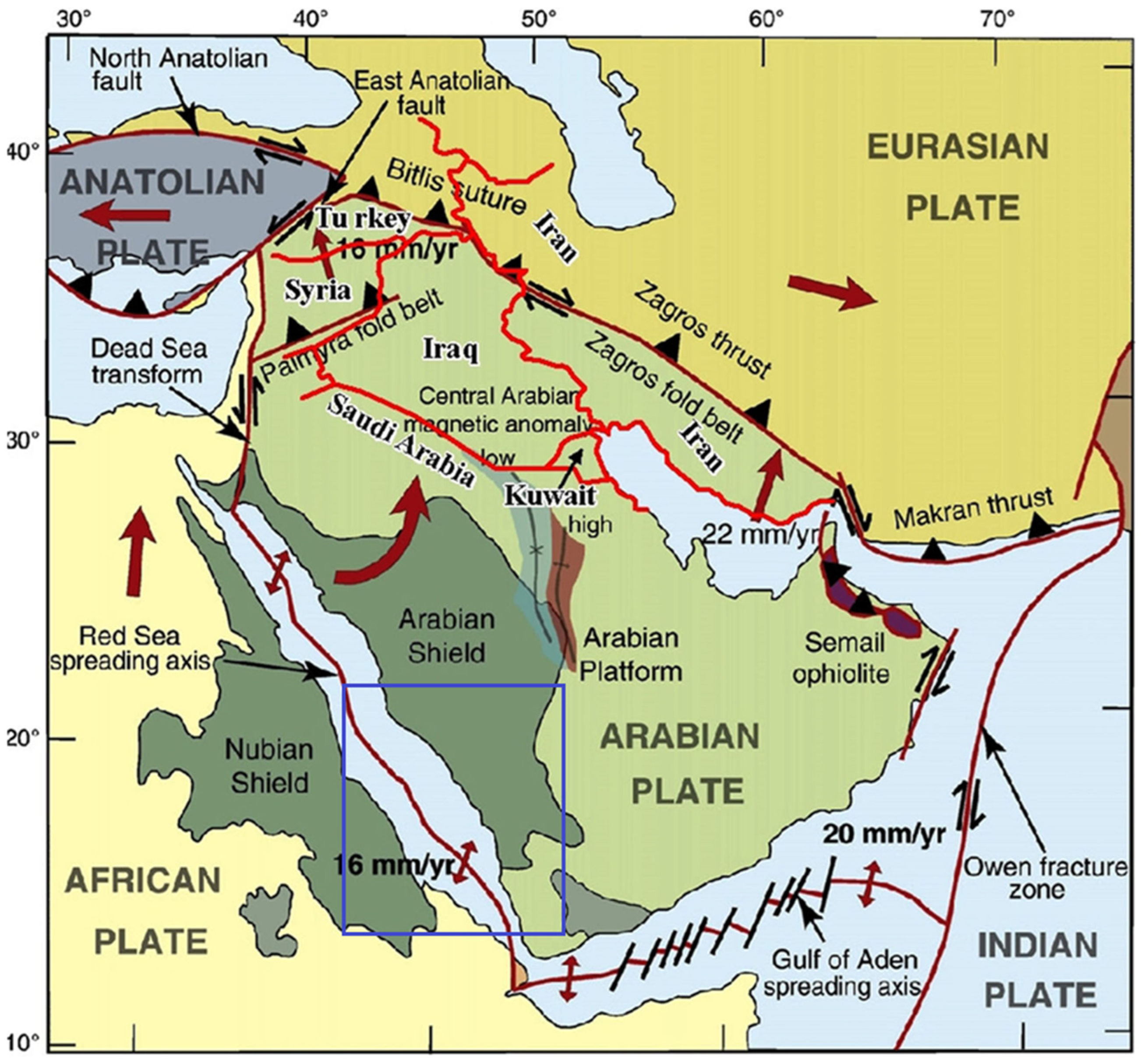
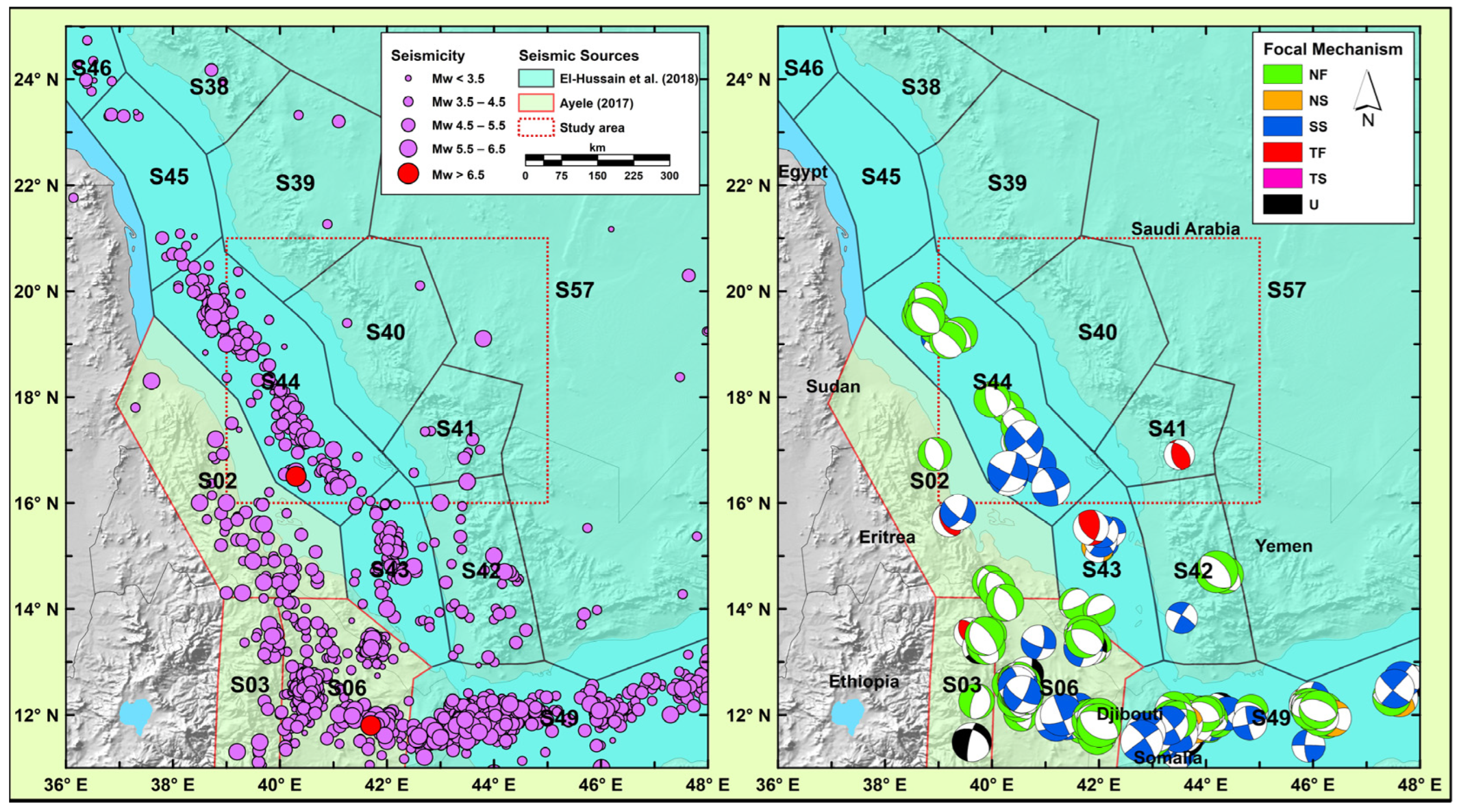
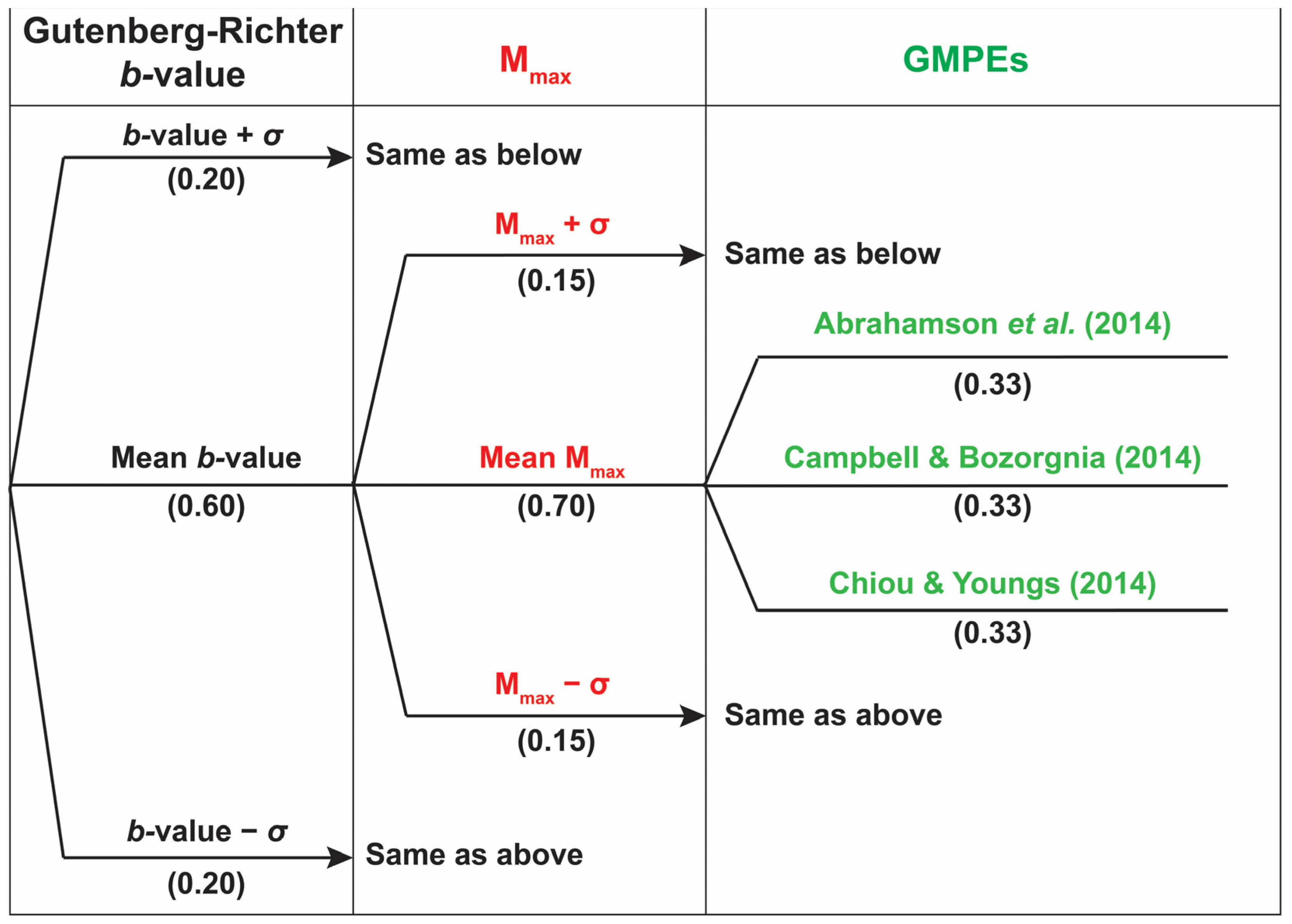
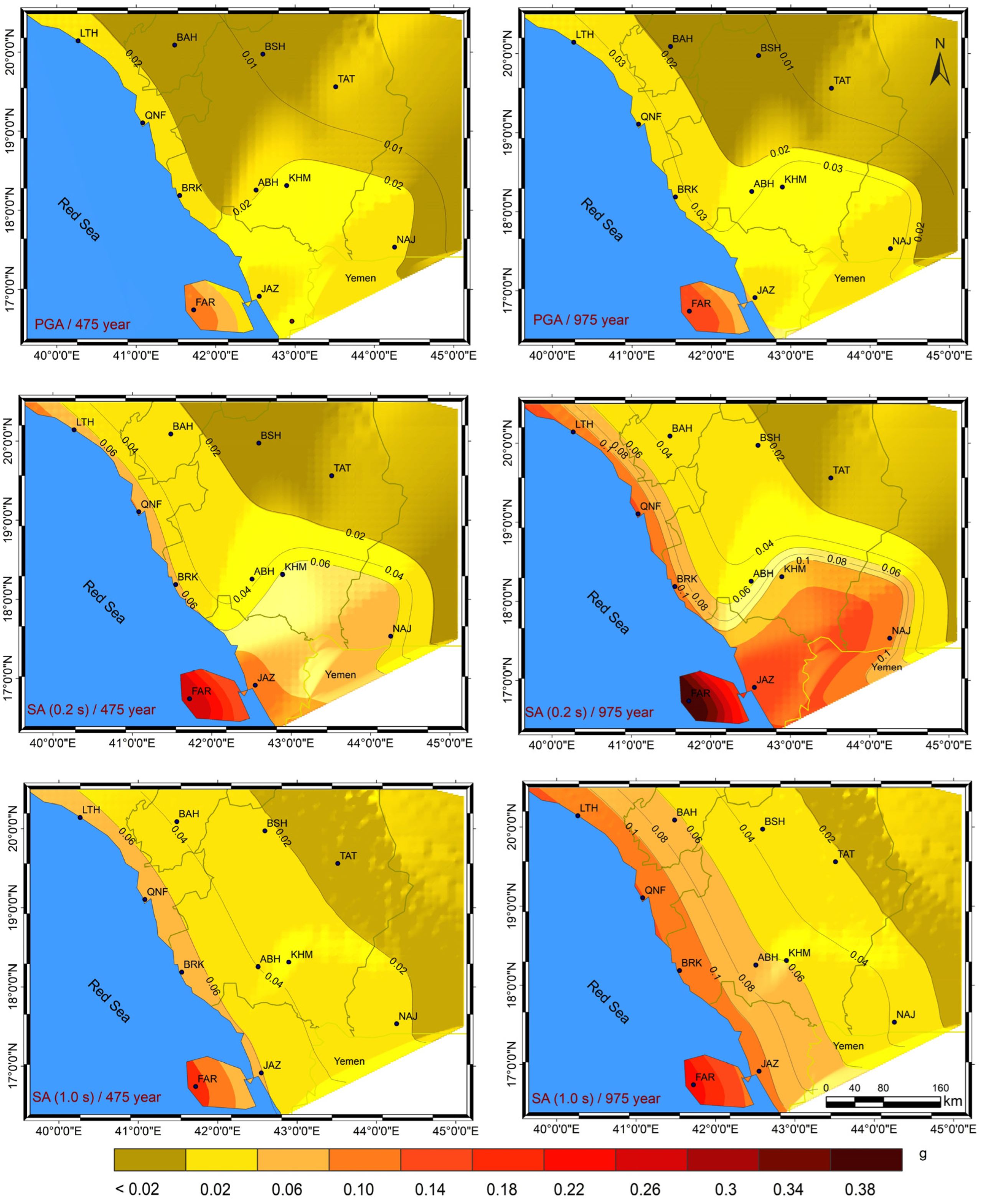
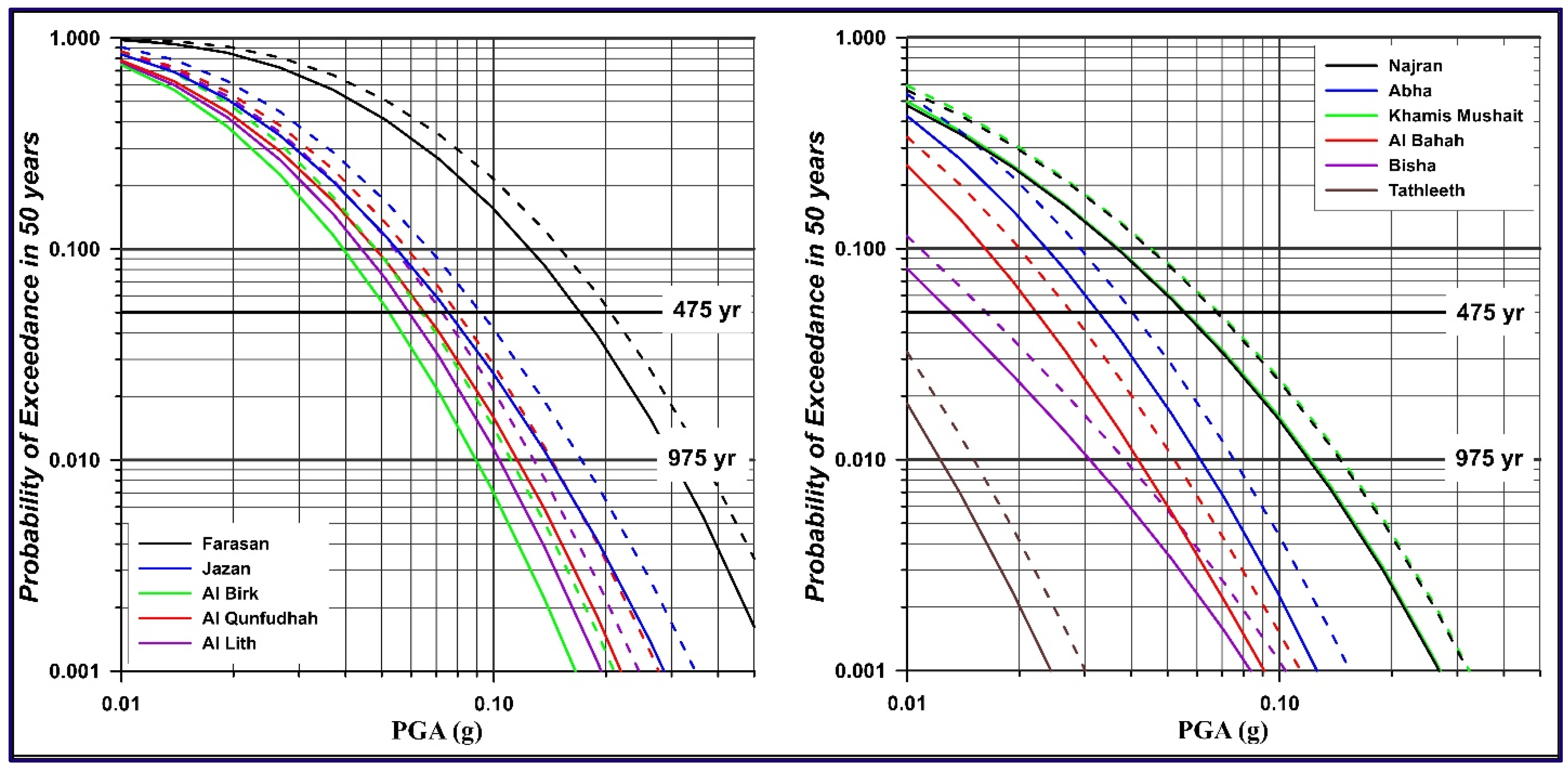
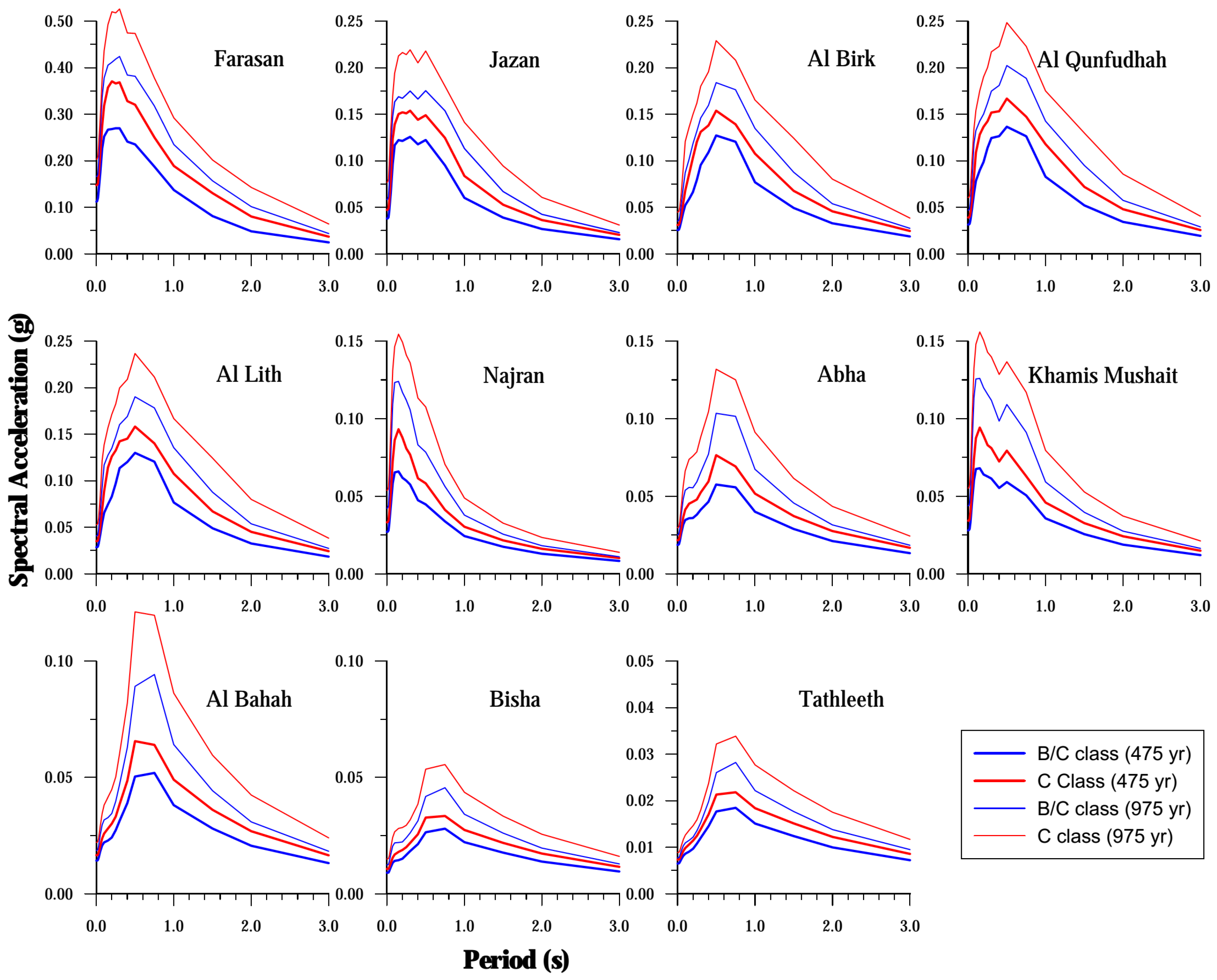
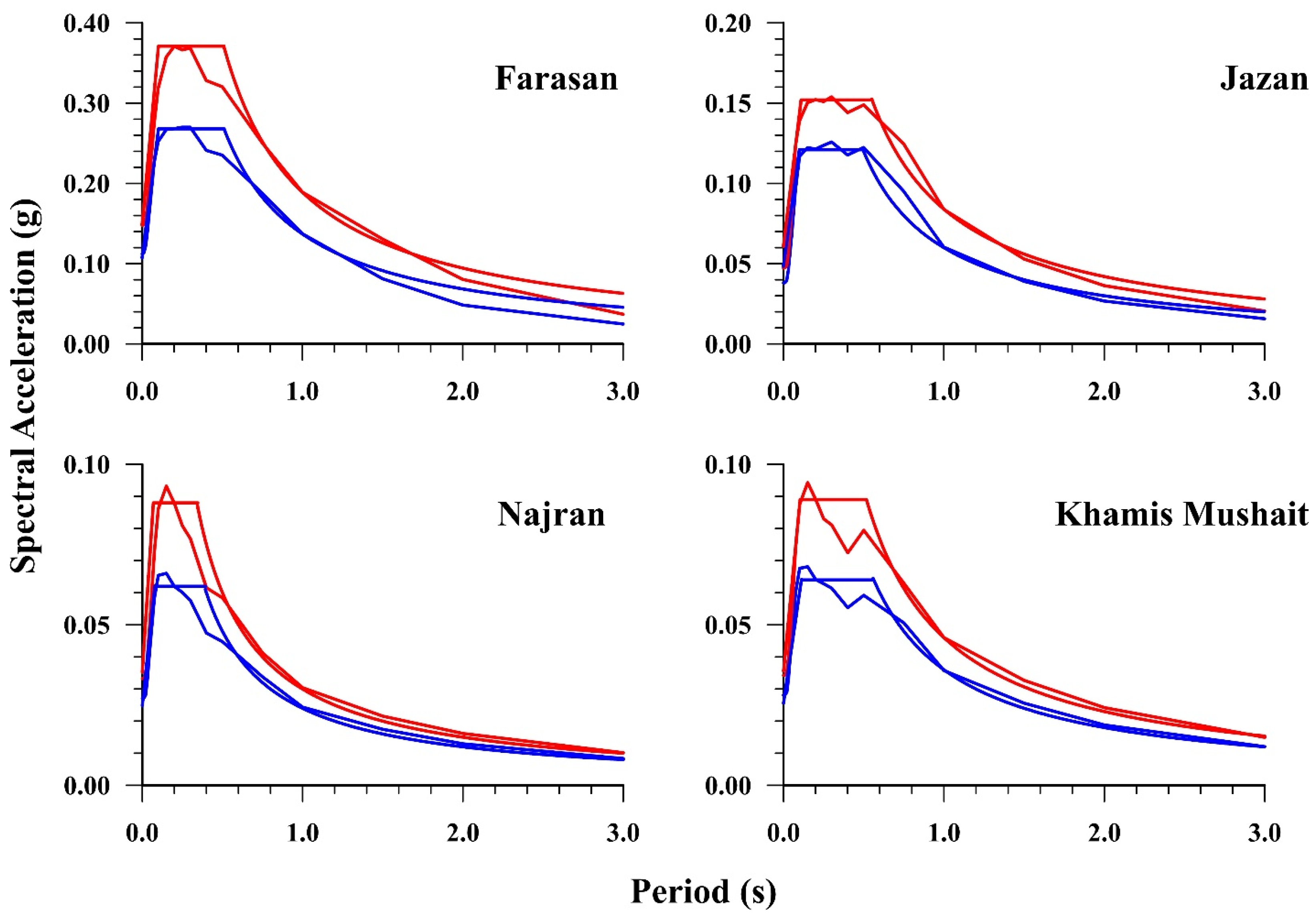

| Source | λ (≥Mw 4.0) | b-Value | Mmax |
|---|---|---|---|
| S02 | 1.21 ± 0.27 | 0.78 ± 0.05 | 7.20 ± 0.18 |
| S03 | 0.54 ± 0.12 | 0.55 ± 0.04 | 5.88 ± 0.13 |
| S06 | 1.59 ± 0.10 | 0.69 ± 0.05 | 6.55 ± 0.16 |
| S38 | 0.10 ± 0.00 | 0.78 ± 0.10 | 6.20 ± 0.30 |
| S39 | 0.06 ± 0.00 | 0.78 ± 0.10 | 5.10 ± 0.30 |
| S40 | 0.05 ± 0.00 | 0.78 ± 0.10 | 4.90 ± 0.30 |
| S41 | 0.21 ± 0.00 | 0.78 ± 0.10 | 5.70 ± 0.30 |
| S42 | 0.52 ± 0.13 | 0.86 ± 0.08 | 6.40 ± 0.31 |
| S43 | 0.44 ± 0.10 | 0.83 ± 0.08 | 6.40 ± 0.32 |
| S44 | 1.54 ± 0.32 | 0.69 ± 0.06 | 7.30 ± 0.34 |
| S45 | 0.10 ± 0.00 | 0.70 ± 0.10 | 5.70 ± 0.30 |
| S46 | 0.03 ± 0.03 | 0.72 ± 0.07 | 6.90 ± 0.31 |
| S49 | 6.22 ± 1.06 | 0.67 ± 0.04 | 6.70 ± 0.31 |
| S57 | 2.00 ± 0.34 | 0.99 ± 0.06 | 6.60 ± 0.31 |
| City * | Site Class | 475 Years | 975 Years | ||||||||
|---|---|---|---|---|---|---|---|---|---|---|---|
| PGA (g) | SA (0.2 s) (g) | SA (1.0 s) (g) | SAmax (g) | Tmax (s) | PGA (g) | SA (0.2 s) (g) | SA (1.0 s) (g) | SAmax (g) | Tmax (s) | ||
| ABH | B/C | 0.019 | 0.036 | 0.040 | 0.058 | 0.50 | 0.025 | 0.055 | 0.067 | 0.104 | 0.50 |
| C | 0.022 | 0.046 | 0.052 | 0.077 | 0.50 | 0.030 | 0.076 | 0.091 | 0.132 | 0.50 | |
| BAH | B/C | 0.014 | 0.024 | 0.038 | 0.052 | 0.75 | 0.019 | 0.034 | 0.064 | 0.094 | 0.75 |
| C | 0.017 | 0.030 | 0.049 | 0.066 | 0.50 | 0.022 | 0.045 | 0.086 | 0.121 | 0.50 | |
| BRK | B/C | 0.026 | 0.066 | 0.077 | 0.127 | 0.50 | 0.035 | 0.118 | 0.135 | 0.184 | 0.50 |
| C | 0.031 | 0.103 | 0.108 | 0.154 | 0.50 | 0.045 | 0.150 | 0.165 | 0.229 | 0.50 | |
| LTH | B/C | 0.029 | 0.083 | 0.077 | 0.130 | 0.50 | 0.041 | 0.135 | 0.136 | 0.190 | 0.50 |
| C | 0.035 | 0.126 | 0.108 | 0.158 | 0.50 | 0.053 | 0.171 | 0.167 | 0.237 | 0.50 | |
| QNF | B/C | 0.032 | 0.099 | 0.083 | 0.137 | 0.50 | 0.047 | 0.150 | 0.143 | 0.202 | 0.50 |
| C | 0.039 | 0.137 | 0.118 | 0.167 | 0.50 | 0.061 | 0.190 | 0.175 | 0.248 | 0.50 | |
| BSH | B/C | <0.01 | 0.015 | 0.022 | 0.028 | 0.75 | 0.012 | 0.022 | 0.034 | 0.046 | 0.75 |
| C | 0.011 | 0.019 | 0.027 | 0.033 | 0.50 | 0.015 | 0.029 | 0.044 | 0.056 | 0.75 | |
| FAR | B/C | 0.112 | 0.268 | 0.137 | 0.270 | 0.25/ 0.30 | 0.166 | 0.412 | 0.235 | 0.424 | 0.30 |
| C | 0.148 | 0.371 | 0.189 | 0.371 | 0.20 | 0.203 | 0.520 | 0.292 | 0.526 | 0.30 | |
| JAZ | B/C | 0.038 | 0.121 | 0.060 | 0.126 | 0.30 | 0.059 | 0.167 | 0.113 | 0.175 | 0.30 |
| C | 0.047 | 0.152 | 0.084 | 0.154 | 0.30 | 0.077 | 0.216 | 0.141 | 0.219 | 0.30 | |
| KHM | B/C | 0.028 | 0.064 | 0.036 | 0.068 | 0.10/ 0.15 | 0.044 | 0.120 | 0.059 | 0.126 | 0.10/ 0.15 |
| C | 0.034 | 0.089 | 0.046 | 0.094 | 0.15 | 0.055 | 0.151 | 0.080 | 0.156 | 0.15 | |
| NJR | B/C | 0.027 | 0.062 | 0.024 | 0.066 | 0.15 | 0.042 | 0.117 | 0.038 | 0.124 | 0.15 |
| C | 0.033 | 0.088 | 0.030 | 0.093 | 0.15 | 0.054 | 0.149 | 0.049 | 0.155 | 0.15 | |
| TAT | B/C | <0.01 | 0.010 | 0.015 | 0.018 | 0.50/ 0.75 | < 0.01 | 0.012 | 0.022 | 0.028 | 0.75 |
| C | <0.01 | 0.011 | 0.018 | 0.022 | 0.75 | < 0.01 | 0.015 | 0.028 | 0.034 | 0.75 | |
| Studied City | Current Assessment | [20] | [101] |
|---|---|---|---|
| Abha | 0.019 | 0.040 | 0.010–0.025 |
| Al Birk | 0.026 | 0.10–0.15 | 0.075–0.100 |
| Al Lith | 0.029 | 0.075 | 0.075–0.100 |
| Al Qunfundhah | 0.032 | 0.075 | ~0.100 |
| Farasan Island | 0.112 | >0.150 | >0.150 |
| Jazan | 0.038 | 0.080 | 0.075–0.100 |
| Najran | 0.027 | 0.065 | 0.025 |
Disclaimer/Publisher’s Note: The statements, opinions and data contained in all publications are solely those of the individual author(s) and contributor(s) and not of MDPI and/or the editor(s). MDPI and/or the editor(s) disclaim responsibility for any injury to people or property resulting from any ideas, methods, instructions or products referred to in the content. |
© 2024 by the authors. Licensee MDPI, Basel, Switzerland. This article is an open access article distributed under the terms and conditions of the Creative Commons Attribution (CC BY) license (https://creativecommons.org/licenses/by/4.0/).
Share and Cite
Arfa, M.; Awad, H.A.; Abbas, H.; Peláez, J.A.; Sawires, R. Probabilistic Seismic Hazard Assessment of the Southwestern Region of Saudi Arabia. Appl. Sci. 2024, 14, 6600. https://doi.org/10.3390/app14156600
Arfa M, Awad HA, Abbas H, Peláez JA, Sawires R. Probabilistic Seismic Hazard Assessment of the Southwestern Region of Saudi Arabia. Applied Sciences. 2024; 14(15):6600. https://doi.org/10.3390/app14156600
Chicago/Turabian StyleArfa, Mohamed, Hamdy A. Awad, Hassan Abbas, José A. Peláez, and Rashad Sawires. 2024. "Probabilistic Seismic Hazard Assessment of the Southwestern Region of Saudi Arabia" Applied Sciences 14, no. 15: 6600. https://doi.org/10.3390/app14156600







